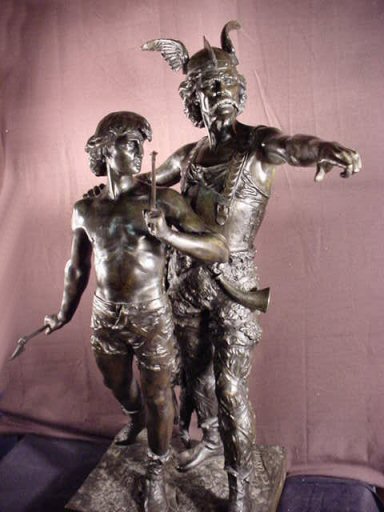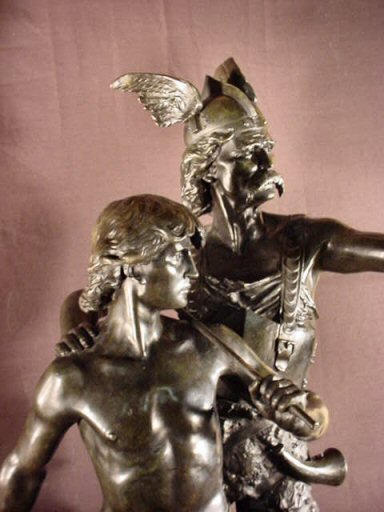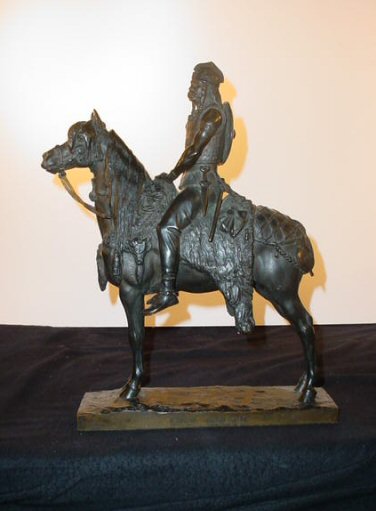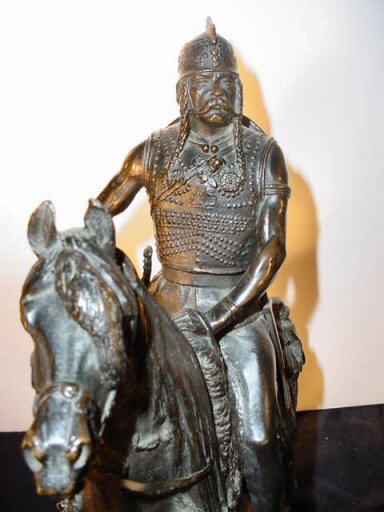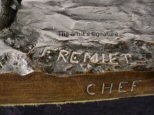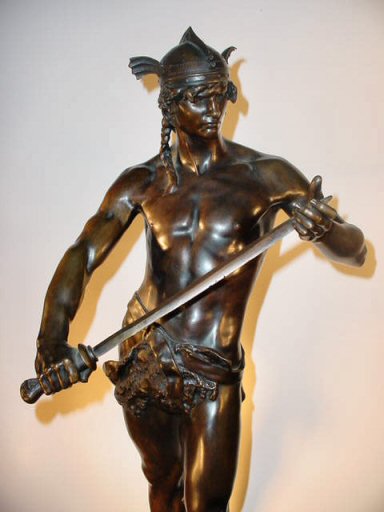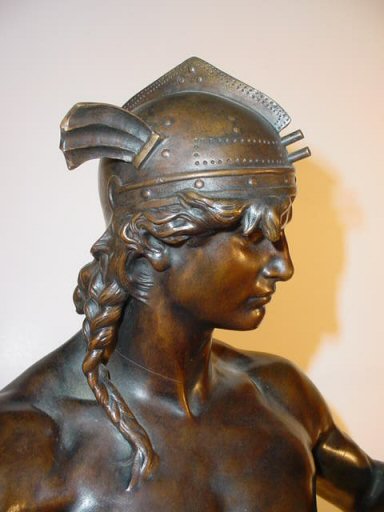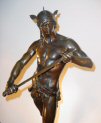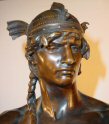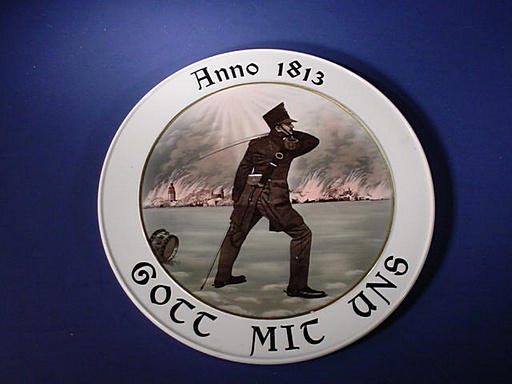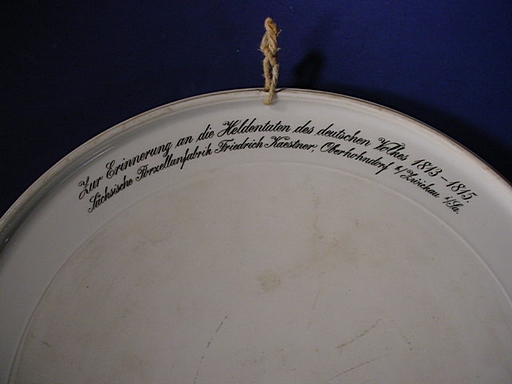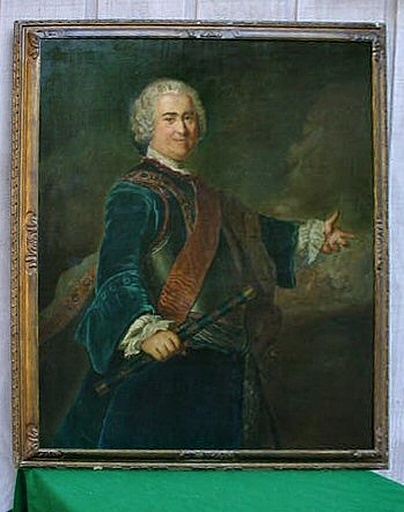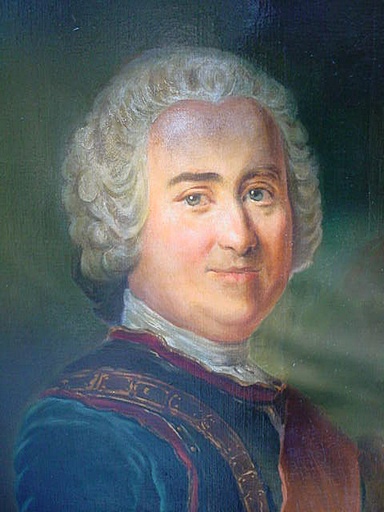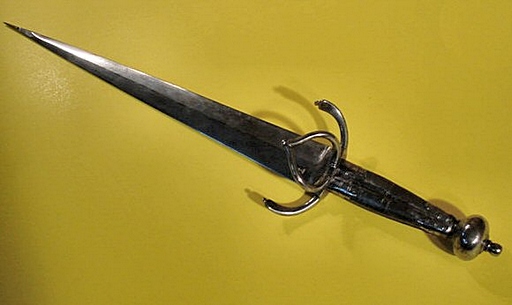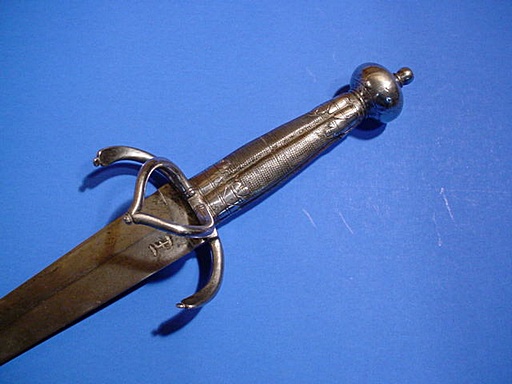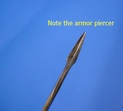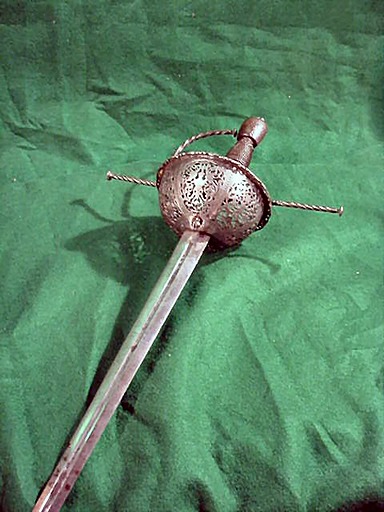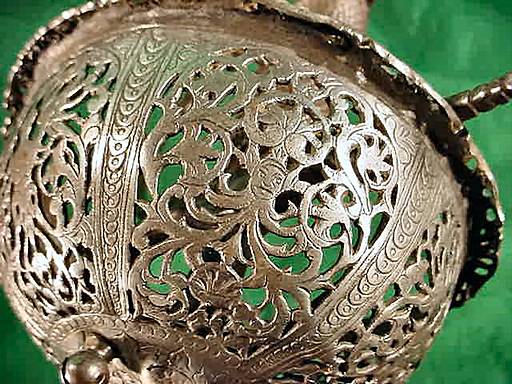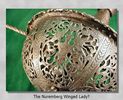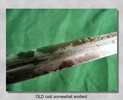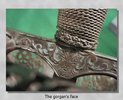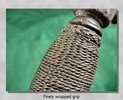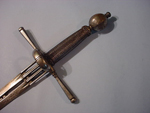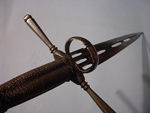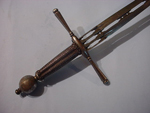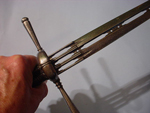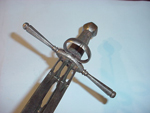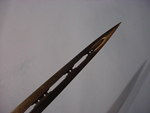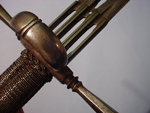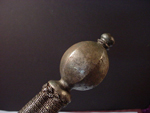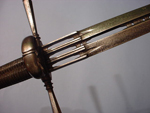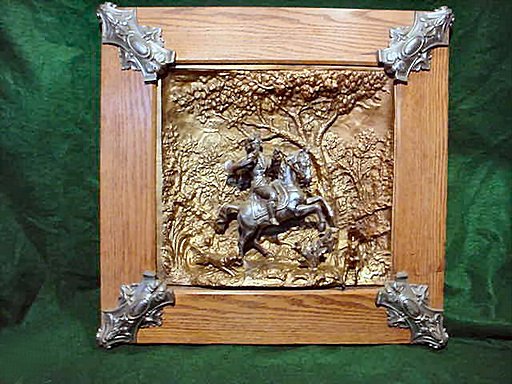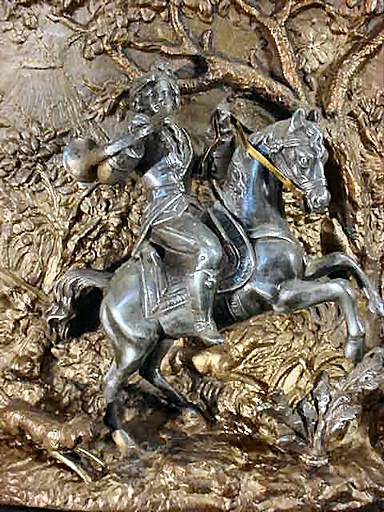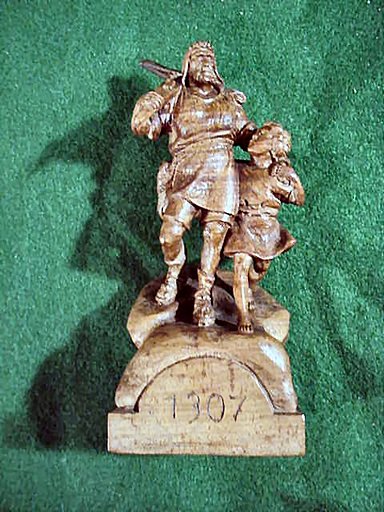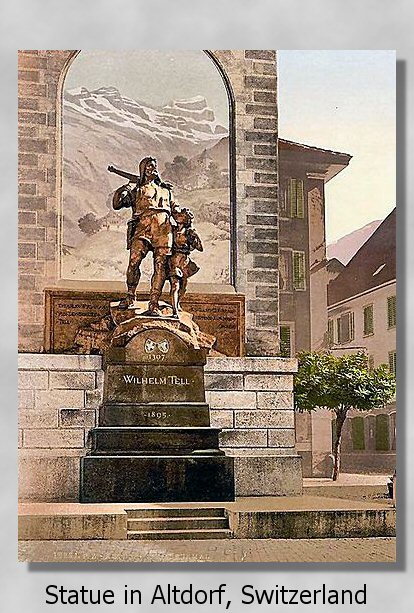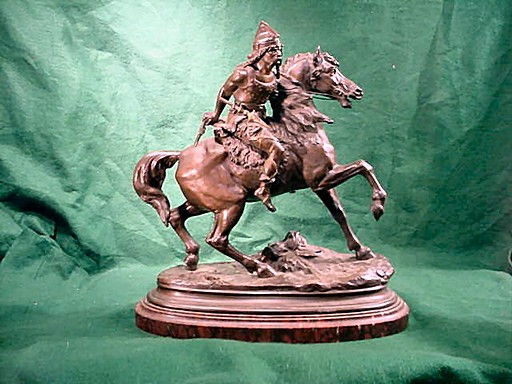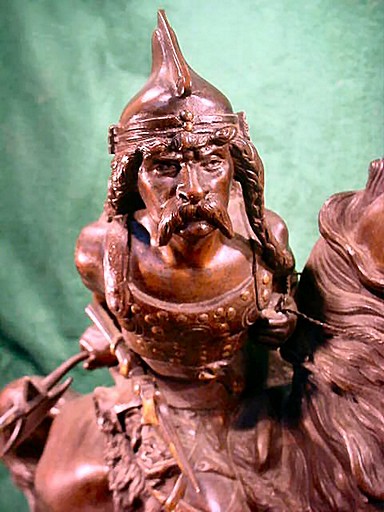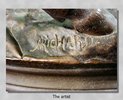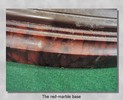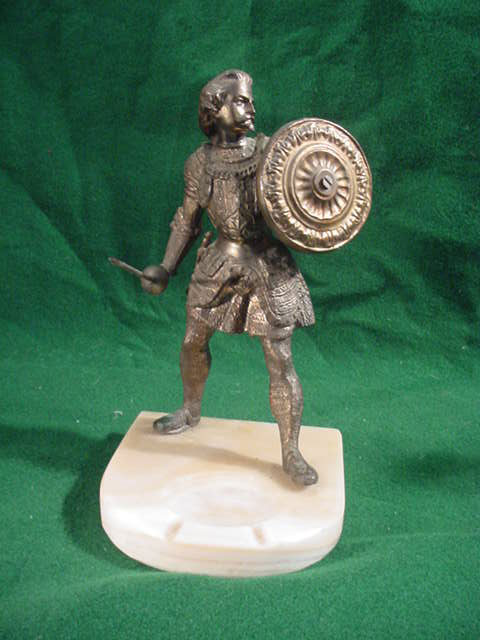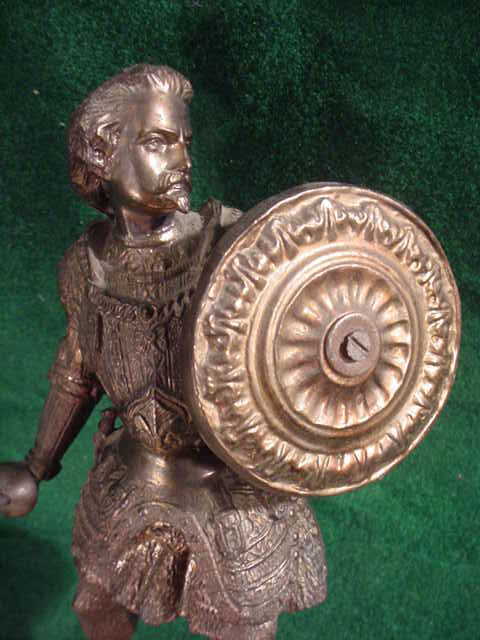|
|
|
|

Old Reich
Page 6
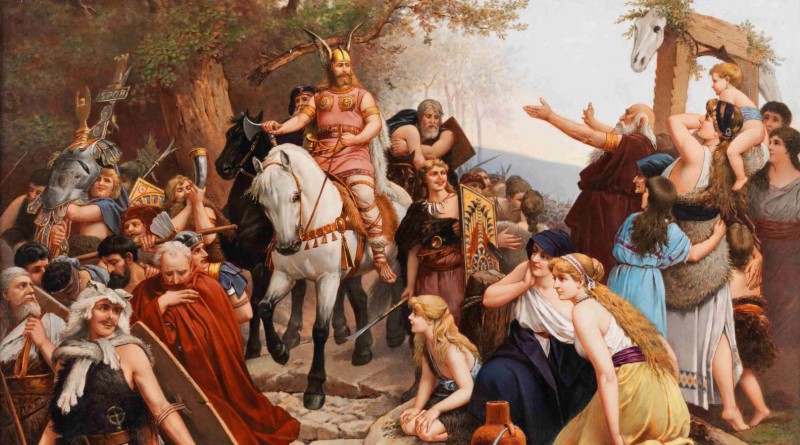
Return of the hero, Hermann, with his Teutonic warriors after the great victory at the Teutoburger Wald
|
||||||||||||||||||||||||||
|
Magnificent Bronze Sculpture of Teutonic Warriors (Item OLD 6-2; BRONZEMET 2-5, KSTATUES 4-1; ART 13-13) |
||||||||||||||||||||||||||
| DESCRIPTION: First of all, let’s emphasize the size of this sculpture: This is a huge piece. It measures 36 inches from the bottom of the base to the top of the warrior’s winged helmet. The base is 14 x 12 inches and is about 4 inches deep. It takes two good, strong men to lift it. The masterful artwork is by Emile LaPort (1858-1907). The name of this sculpture is “Pro Patria.” The foundry mark is Siot Decauville Fondeur Paris. Emile LaPort was a genre/landscape painter and sculptor of renown, who exhibited at Salon from 1881 to 1906. He sculpted “Pro Patria”/Gauois (Teuton) with Son, identical to Bonnardi’s Teuton and Son minus the sword on the son’s hip. His works can be found in museums—Angers, Autun, and Tourcoing. “Pro Patria,” the name of the sculpture, can be interpreted as “For Fatherland.” Yes, the Teutons were patriotic and this father as depicted seems to be teaching his son the use of weapons and the ways of war. In the period when this sculpture was created the French seemed more inspired by the old Teutons and Gauls than the Germans were. Thus, many of the best of the statues in bronze of Germanic warriors were produced in France. This study is by far the greatest of all such inspiring studies. When one of these “Pro Patria” sculptures does rarely show up over the years, invariably it is missing the ax and spear that is carried by the young lad. About 5 years ago we encountered one at an antique show in Miami Beach, Florida. Not only were these mentioned appendages missing, but also the sword from the waist of the father figure was missing. This sculpture is complete with all weapons and is in marvelous condition. This is a highly dramatic depiction of life and high adventure among the so-called Barbarians of the Germanic forests and glades. This is a museum piece personified, yet a cultured Germanophile would be more than proud and fortunate to count this masterpiece in his collection. Action bronzes today are bringing huge prices at fine antique fairs. We are offering this the absolute greatest sculpture in this particular designated artistic expression at a very competitive price.
PRICE: $24,500.00 |
|
||||||||||||||
|
Gaulish Warrior on Horse; Art Bronze of the 1890s by Emmanuel Fremiet (Item OLD 6-4; ART 14-4; KSTATUES 4-4) |
||||||||||||||
| DESCRIPTION: This is a beautiful bronze executed by the famous French sculptor Emmanuel Fremiet (1824-1910). Fremiet was a nephew of Rude. His first employment was drawing animals for the Natural History Museum. His family came to Paris from the country, a love for which is apparent in his early gentle animal sculptures. As he progressed and gained more state and private commissions than he could handle, animals took a secondary role in his groups. Yet, for all the pressures to produce he must be admired for his historically important figures and for his meticulous accuracy of uniform, armor, saddle, artists, etc. He was known for monumental figure groupings that can be seen in Paris and throughout France, and works such as this Gaul warrior were also produced and edited in reduced bronze editions. Fremiet’s great works and continued popularity make these mini monuments highly valued when found today. The bronze is in perfect condition except for the reins that are there but are disconnected at the holding end. This can be a attended to very easily. The name of the statue (engraved on the base) is “Chef Gaulois,” Chief of the Gauls. The wonderful sculpture has all the boldness of the heroic stance of the warrior leader. The armor on the horse and man, the weapons, and various accouterments serve to make this a beautiful and important art treasure. The measurement is about 15 inches from the bottom of the base to the top of the Gaulish helmet and about 11 inches from the tail of the horse to this now. The chief by himself is about 10 a half inches tall in the saddle. The sculpture is clearly marked Fremiet on a plate. At the rear of the horse’s armor are the letters “SPQR.” This is evidence of fierce battles that were fought by the Germanic tribes against the legions of Rome. This is a captured war trophy taken by this Gaulish leader. His sword, dagger, and ax are all typical of the weapons of the Germanic warrior societies. This is a very worthwhile investment for the serious collector of Germanic art.
PRICE: $3,800.00 |
|
|||||||||||||||||||||||||||
|
Bronze Teutonic Warrior (Battle of the Teutoberger Forest) (Item OLD 6-5; ART 14-5) |
|||||||||||||||||||||||||||
| DESCRIPTION: This is a masterpiece of a bronze sculpture by a famed French artist Andre-Paul Arthur Massoulle (1851-1901) who had depicted a warrior who fought the Roman legions and the world's most important battle, the battle of the Teutoberger Forest in 9 A.D. Three legions of the Roman army under the Roman commander, Quintilius Varus, crossed the Rhine to establish new provinces deep in the heart of Germania when an alliance of German tribes, led by Arminius of the Cherusci, ambushed and utterly destroyed these invading legions. This is one of the most decisive battles of history. It was a major defeat for the Roman Empire and ended its expansion in northern Europe and, thus, was probably the greatest disaster ever suffered by the crack Roman legions XVII, XVIII, XIX. According to the Roman historian Suetonis, the Emperor Augustus, when he was told of the horrible defeat cried out, “Quintilius Varus, give me back my legions!” The Romans for all their efforts to conquer Germany between 12 B.C. and 16 B.C. met with very limited success. The brave Germans held their ground tenaciously and Roman leadership varied in quality. They could not consolidate their rule in most of Germany or establish the Elbe as their outermost European frontier. The battle was bloody; the Commander Varus took his own life by throwing himself on his sword. A few other important officers killed themselves in the ensuing combat. About 20,000 soldiers were massacred. Varus’ head was sent to Augustus; prisoners were horribly tortured in the most heinous manner. Some were burned alive, many were sacrificed on the altar in the sacred groves by the Germanic priests. For additional information on the battle go to Item OLD 3-2. Massoulle named this work “Sword of the Brave.” The size is unusually large for this artist. It measures 30 inches tall. Although he sculpted several historical bronze statues, he was famed as a medalist and his works gained many honors and he was titled and awarded the office of Knight of the Legion of Honor. He was born in Epernay (the Marne) and died in Paris at the age of 50. He was a pupil of the great sculptors Salson and Cavelie. So, he is rated very highly among European sculptors, and if the statue is an example of his work, you can readily see why. The figure is quite significant and is historically correct. The young warrior stands proudly holding the captured Roman sword while he stands upon the broken standard of the Roman legions. Traditionally, when the enemy in war was defeated the regimental or legion standard is cast to the ground and tread upon. This is an extremely dramatic statement in art. Seldom does something as fine as this appear on the art market; even in Europe.
PRICE: SOLD |
|
|||||||||||||||
|
Porcelain Plaque of Battle of Nations at Leipzig, 1813 (Item OLD 6-6; KGLASS 2-15) |
|||||||||||||||
| DESCRIPTION: This is utterly fantastic! It commemorates one of the most famous battles of all the world’s history: the Battle of Nations by the city of Leipzig. We will not write out the history of that earth-shattering battle in Europe’s life-and-death fight against Napoleon because it is available in several locations on the internet. Look to Wikipedia under “the Battle of the Nations” or in German, “Volkerschlacht bei Leipzig.” This was one of the most decisive defeats suffered by Napoleon Bonaparte. It’s considered the largest battle in Europe before WWI with over 500,000 troops involved: Italy, Naples, Duchy of Warsaw, Russia, Austria, Prussia, Sweden, the United Kingdom, and the French Empire under Napoleon. Sixty-seven thousand were killed or wounded. It was the beginning of the end for the Corsican corporal who up to now was the greatest military strategist and most powerful man in Europe (read about it; you’ll find it fascinating.) The plaque measures 11 1/2 inches in diameter and is in perfect condition. It depicts a Prussian officer who brandishes his saber menacingly against the French foe. Behind is the city of Leipzig in flames from the horrible conflict. On the back is the legend as follows and translated: “In memory of the heroic deeds of the German people, 1813-1815. Saxon Porcelain Works Friedrich Kaestner, in Oberhohndorf by the Zwickau River.” At the bottom is the mark of Kaestner with the double hammers. The firm is recognized and is listed in the book Marks on German, Bohemian, and Austrian Porcelain, 1710 to the Present. It was in business up to 1972. According to the mark we believe this was manufactured in about 1938. On the front is “Anno 1813,” representing the year of the Battle of Leipzig. Under this it proclaims “GOTT MIT UNS,” “God with us.” The picture appears to be hand painted under the glaze. This is a beautiful, dramatic presentation; a museum-worthy investment piece; a Germanophile’s dream!
PRICE: $785.00; absolutely wonderful |
|
||||||||
|
Giant Portrait of Marshal of Prussia James Francis Edward Keith (Item OLD 6-7; KPAINTING 1-18; FRED 3-10) |
||||||||
| DESCRIPTION: This is a magnificent oil painting of James Keith, who was one of the Scots who left Scotia to fight and direct the wars of central Europe. The fighting Scots were never content to till the soil or to sit in the counting houses. They were warriors and the absolute greatest soldiers that the world has ever seen. It is only too bad that they ever lifted the Claymore for England (my Scottish opinion!). Over the centuries Scottish men have embarked for Germany knowing that at least in Prussia their specialty (warfare) would be appreciated and the German monarchs would be delighted to avail themselves of these services. Many Johnstons, Armstrongs, Andersons, and the brothers Keith heeded the call of Frederick the Great and the Hohenzollern kings such as the Wilhelm I and II. They were like “jewels in the crown” to the Prussians and the Scots usually settled there and their families still remain fully Germanicised, but proud of their Scottish beginnings and heritage. Sir John Keith was no exception; in, fact he proved the rule. Keith, 1696-1758, was Scottish field marshal of Prussia; brother of George Keith, 10th earl marischal (marshal) of Scotland. He participated in the Jacobite uprising of 1715, and in the abortive invasion of 1719 with is brother. Escaping to the Continent, he first entered the Spanish service and then went to Russia, where he gained honor in both civil and military offices. Later, he went to Prussia and became close friends with Frederick the Great, who made him a field marshal (1747). Keith entered the circle of Europe’s leading intellectuals and rendered great service to Prussia in the early part of the Seven Years War. He was killed in the battle of Hochkirch. The painting is beautifully executed, although unsigned. It’s in its original frame and we guess the canvas was done about 1860 or 1870 and it seems to be the original frame, but such as it is, the frame is not nearly as nice as the painting. So our suggestion is that a new, very fancy frame would enhance this piece very nicely. On the back of the frame there was a sticker that has seen better days. In fact, when we moved the painting the sticker came off, but we have preserved it. The sticker or tag gives an address for Mrs. Charles Oswald Liddell of Blinkbonnie (Estate?) in Pinehurst, New Jersey. Written in hand underneath it says: “Field Marshal Lord James Keith; brother of 10th Earl.” Liddel is a Scottish name and Pinehurst was settled by Scottish settlers. Pinehurst is called the Home of American Golf. Golf equals Scottish national pastime. Blinkbonnie Rockliffe is a tiny coastal villa in Scotland and Blinkbonnie is used by guest houses, golf courses, etc., in North Carolina. We found many Liddells on the web and almost all were in North Carolina, but we didn’t find Mrs. C. Oswald Liddell, yet, but we are sure with a bit more intensive search we will come up with the right branch of the family. Could this painting at some time in its history have hung in a grand estate or possible a golf course recreation building or dining hall? The canvas in its frame measures 55 x 45 inches. On the back of the stretcher is a label that is from the Scottish art dealer who sold it probably directly to Mrs. Liddell back then. The dealer was Doic, Wilson & Wheatley, Fine Art Dealers & Printsellers, Picture Restorers & Framers to His Majesty the King. It was established in 1840 and was located in Edinburgh. So, the canvas from all information provided is Scottish all the way, even though Lord Keith’s fame was mostly earned as a Prussian field marshal of great renown. This is a marvelous find and would grace a Scottish collection or a Germanophile would do well to display this great canvas of the marshal extraordinaire!
PRICE: $7,500.00 |
|
||||||||||||
|
Medieval Armor-Piercing Dagger (Item OLD 6-8) |
||||||||||||
| DESCRIPTION: Here is a gem of a museum piece; a fine medieval dagger of the stiletto style. This is one of the finest examples we have seen; very museum-collection worthy. It is larger than the examples usually encountered being a full 19 inches long with the blade at 13 inches of that. The handle wire wrapping is incredibly tight. The heart-shaped clamshell guard is open with supporting quillons, or cross guards, emanating in a forward pattern. The pommel is in polished iron as are the other fittings. The blade is in perfect shape and concludes with a tip that is spear pointed and thick in order to penetrate chain mail (very vicious). The blade has an armorer’s mark stamped into it at its widest point that looks like a ‘T’ intertwined with a ‘TD’ with the ‘T’ superimposed over the ‘D.’ This is a genuine medieval piece and probably dates 1590 to as late as 1610. Some would call this a left-handed dagger indicating that it would be the weapon that the owner would face his opponent with, while thrusting with his sword held in the right hand. This would enable him to have distinct advantage against the adversary. This is the type of weapon carried by the bodyguards of the electors of Saxony. It’s of fine quality and excellent condition; a great museum piece.
PRICE: SOLD |
|
||||||||||||||
|
Brescia Cup Hilt Rapier (giant size)(original period piece) (Item OLD 6-9) |
||||||||||||||
| DESCRIPTION: This is wonderful example of the famous cup hilt rapier. The steel hilt is chiseled with winged and bare-breasted female. It’s from the third quarter of the 17th century. It’s similar to one shown in the book Price Guide to Antique Edged Weapons produced by Leslie Southwick. Pictured on page 56 figures 117, 118, and 119 the quillons, the wire wrap, and the chiseled steel cup are obvious. Spanish cup hilts are also similar, but we are sure this was produced in Brescia, a province in Italy famous for weapons production; some of the finest swords were produced there and they were marketed throughout the world, often on special order. Some Italian swords were considered even finer than German ones produced in Bamberg, Augsburg, and Solingen. The figures on the cup guard of this rapier look to us like the symbol for Nuremberg Der Stadt der Edlen Kunst, the City of Noble Art. The city of Milan was for centuries the trading center for Brescia weapons. The bare-breasted female figure and even the court jester seen in other panels of the cup put one in mind of the age-old symbols of my favorite German city, Old Nürnberg. The city was incorporated in 1219 and became one of the most important cites in Bavaria. The city symbol was of the king’s head on the body of an eagle, but through the ages the Nürnbergers often displayed it as an eagle’s body with female head and breasts. Anyway, this design stands out as looking much like the design on the cup hilt of this rapier. Court jesters were a feature of old Nuremberg mirth and show up in various artworks of the 16th and 17th centuries. The possibility of this being a weapon purchased and carried to Germany is very possible. We only speculate here, but that’s what being a historian often entails. In any case, we have here a spectacular sword indeed; a real museum relic of prodigious importance. The sword is very unusually long; about 47 inches all totaled and the blade is 38 inches with a 13 1/2-inch blood groove. It is unsigned. The pommel is different than the ones pictures in the aforementioned book in that it does look to be the type favored by the Germans; however, everything else is very much like the pictured rapiers. Two screws cut and designed hold the quillons to the frame. The overall condition is really good. There’s no scabbard, of course. These were of leather and would have rotted away years ago. We are quite proud to offer this magnificent weapon of yesteryear to our collectors and are secure in the knowledge that it is indeed an original-period piece and very historically important.
PRICE: $6,500.00 (Traded - no longer available) |
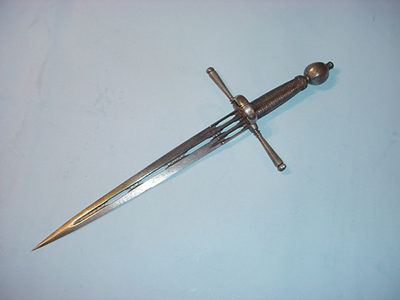 |
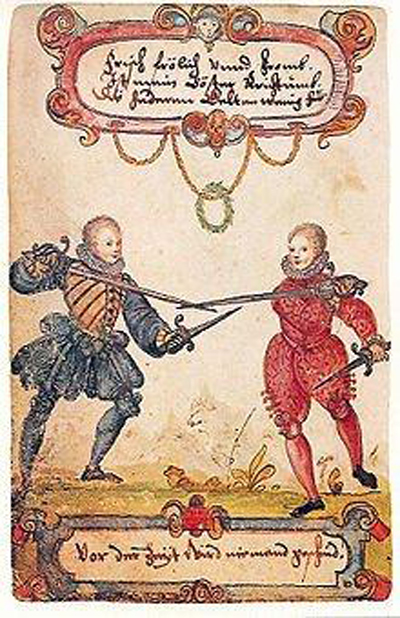 |
Saxon Left Hand Dagger (Item OLD 6-9a) |
DESCRIPTION: Prior to the 18th century, (and later in some areas such as Spain and parts of Italy) a weapon was often held in the opposite hand from the sword for use in parrying attacks and occasionally to add offence. When specially designed for the purpose, the parrying dagger was often referred to as a main-gauche (*French for left hand). These weapons were made and supplied to the military of some countries but also to the civilian or adventurer or: gallant swordsman, the idea of the long quillions was to catch the sword of the opponent and force it down for that split second required to make the fatal thrust with the sword or if the opponent is pinned with the sword momentarily then this dagger could be utilized for the death dealing thrust. In any case, the bearer of this heinous weapon certainly meant business! The ring at the cross guard was also to catch the opponents sword as well. If our hero managed to catch the opposite’s sword in this ring then it was all over for that bad guy or is it good guy? The feel of this weapon in the hand sums all sorts of strange feeling. It feels instantly lethal! The piercing on the blade is highly unusual. We have seen pierced blades with blood gutters before but never this elaborate! This one is incredible! It is of Saxon origin and dates around 1600. The entire look of it would surely dissuade any opponent wishing to duel with its owner. Most deadly appearing! Length is 18 inches overall with excellent tight grip wrapping & typical Germanic globe top. Wonderful state of preservation with no pitting. It probably was in a museum setting for many years. A prodigiously important historical piece. PRICE: SOLD |
|
|||||||||||
|
Germanic Hunting Scene (Item OLD 6-10; HUNT 7-14) |
|||||||||||
| DESCRIPTION: This is a beautiful Germanic hunting scene depicting a medieval huntsman blowing the “Horrido“ horn that signals the beginning of the royal hunt. The perception is the 16th century and the whole thing is built in a relief motif with the hunter, the hound, and the prey, all worked in white metal and bronze. We believe this scene is in its original massive frame. The piece is very heavy, seeing as the main body of it is solid bronze. We think it’s from a German hunting lodge of the 1860s or 1870s. The entire unit with its frame measures about 22 inches square. The actual scene is 15 x 13 1/2 inches. There are beautiful corner caps in white metal, possibly iron. The horseman is cast in white metal, also possibly iron, or it could be silver-plated bronze. This is truly a museum piece, or for a collector of Germanic furnishings or hunting-related items. The word that best describes it has to be “stunning!”
PRICE: SOLD |
|
|||||||
|
Wooden Carving of William Tell and His Son (Item OLD 6-11) |
|||||||
| DESCRIPTION: This is a magnificent little wood carving of the famed crossbowman William Tell, of everlasting Swiss fame. This story became one of Germany’s favorites, as well as Switzerland‘s. This hero was said to have lived in the canton of Uri in Switzerland in the 14th century. He was known as an expert marksman with the crossbow. The newly-appointed Austrian Vogt (occupation leader) of Altdorf, raised a pole in the village’s central square with his hat on top and demanded that all local townspeople bow before it. As Tell passed by without bowing, he was arrested. He received the punishment of being forced to shoot an apple off the head of his son, Walter, or else both would be executed. Tell was promised freedom if he shot the apple. On November 18, 1307, Tell split the fruit with a single bolt from his crossbow, without mishap. When Gessler queried him about the second bolt in his quiver, Tell answered that if he had ended up killing his son in that trial, he would have turned the crossbow on Gessler, himself. There was a famous German play whose debut performance was held in the winter of 1512 in Altdorf. This was the oldest existing written version of a Tell play, although there have been many since, but the most famous was Fredrich Schiller’s play “William Tell” (Wilhelm Tell). The carving is about 6 1/2 inches high, and its base is 3 1/2 x 2 inches. The carving for such a small price is phenomenal! It has really great detail. This is one of the most difficult art forms to bring out facial features and flowing lines of garments. It has been magnificently accomplished here. Note the famous statue in bronze in Switzerland and see how accurately the German carver accomplished it. It probably dates in the turn of the 18th century.
PRICE: $475.00 |
|
|||||||||||||
|
Bronze Sculpture of a Teutonic Warrior on Horseback (Item OLD 6-12; ART 15-6) |
|||||||||||||
| DESCRIPTION: Here is a really great bronze sculpture of a Teutonic (Alte-Germanian) warrior in equestrian grouping. This is an excellent portrayal of the Germanic warriors that defeated the Romans at the Battle of the Teutoberger Forest in the year 9 A.D., when an alliance of German tribes led by Arminius (Hermann) of the Cherusci ambushed and destroyed three Roman legions led by Publius Quinctilius Varus. After this Hermannschlacht the Roman Empire made no further attempts to conquer Germania beyond the Rhine. This absolutely accurate and wonderful bronze captures all the exuberance and ferociousness of the spirited tribesman as he rides to glory in battle. He is equipped with battleaxe and the short spear-pointed sword peculiar to the Cherusci. For more information on this battle, search the web. The statue is very heavy with its beautiful red-marble plinth, or base. It’s signed ‘A. Richard.’ It stands about 18 inches high. The base is about 17 inches long by 8 inches wide. From the tail of the horse to his front hoof it measures about 15 inches. The red-marble base is about 2 inches thick. This is just a great bronze sculpture representing the most important victory in the history of the world; a battle fought defensively to protect its nation—the only justifiable war. Take notice (W); defense, not aggression.
PRICE: $3,500.00 |
|
|
||
|
A Fighting Warrior Ash Tray (Item OLD 6-13) |
||
| DESCRIPTION: This figural ash tray was probably produced in Germany in the 1920’s. It depicts in “German Silver” (white metal) a 15th century soldier with sword and shield at the ready. He stands on a marble base cut for the petite cigars of the time. This was the sort of thing found in military officers smoking cars in the German Railroad System. The figure is about 9 inches high and the base is about 4 ½ inches wide. He is in good condition. There is a screw holding the shield in hand but this doesn’t really detract from the rather dramatic effect of the presentation. A nice desk piece or den decoration..
PRICE: SOLD |
Page Six |
Please refer to item designator in parentheses in all correspondence.
Please E-mail for any additional information you may need.If you prefer, contact 'Germania' at PO Box 68, Lakemont, GA 30552
or call at 706.782.1668 or 706.782.4398.
Please! do not call during the wee hours of the morning. The best time for calling us is between 10 and 11 am and between 9 and 11 pm eastern time.


